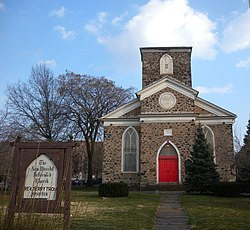New Utrecht Reformed Church
New Utrecht Reformed Church and Buildings | |
 | |
40°36′30″N 74°0′3″W / 40.60833°N 74.00083°W / 40.60833; -74.00083 | |
| Area | less than one acre |
|---|---|
| Built | 1828 |
| Architect | Valk, Lawrence; Et al. |
| Architectural style | Shingle Style, Georgian, Richardsonian Romanesque |
| NRHP reference No. | 80002634[1] |
New Utrecht Reformed Church Complex (Boundary Increase) | |
| Location | 8523 16th Ave., Brooklyn, New York |
| Area | less than one acre |
| Built | 1653 |
| NRHP reference No. | 01000126[1] |
| Significant dates | |
| Added to NRHP | March 5, 2001 |
| Designated NYCL | March 15, 1966 January 13, 1998 (extension) |
| Added to NRHP | April 9, 1980 |

New Utrecht Reformed Church is the fourth oldest Reformed Church in America congregation and is located in Bensonhurst, Brooklyn, New York.[2] The church was established in 1677 by ethnic Dutch residents in the town of New Utrecht, Brooklyn, several years after the English took over New Netherland. It is affiliated with the Reformed Church in America, a Protestant denomination. The cemetery was consecrated in 1654; 1300 dead are interred there. The Liberty Pole, the sixth on the site of the present church, was originally erected in 1783 at the end of the Revolutionary War to harass departing British troops.
The present church was built in 1828 of stones taken from the original church, built in 1700. Construction was supervised by US Army engineer, Rene Edward De Russy, who led the construction of Fort Hamilton at New York harbor.[3][4] The parish house was built in 1892 and the parsonage in 1906.
The church was designated as a National Historic Landmark in 1966; the parish house and the cemetery received landmark status in 1998. Both the church and the cemetery are listed in the National Register of Historic Places.[5][6]
- Steeple
-
 Parish House
Parish House -
 Church
Church
See also
- List of New York City Landmarks
- National Register of Historic Places listings in Kings County, New York
- Reverend Johannes Arondeus
References
- ^ a b "National Register Information System". National Register of Historic Places. National Park Service. March 13, 2009.
- ^ "About Us", New Utrecht Reformed Church
- ^ Eicher, John; Eicher, David (2002). Civil War High Commands. Stanford University Press. p. 207. ISBN 9780804780353. Retrieved 16 October 2017.
- ^ "DE RUSSY DRIVE, Dyker Heights". forgotten-ny.com. Forgotten New York. Retrieved 16 October 2017.
- ^ Holly Huckins; Joan Olshansky & Elizabeth Spencer-Ralph (September 1979). "National Register of Historic Places Registration: New Utrecht Reformed Church Complex". New York State Office of Parks, Recreation and Historic Preservation. Retrieved 2011-02-20. See also: "Accompanying seven photos".
- ^ Peter Shaver (October 1997). "National Register of Historic Places Registration: New Utrecht Reformed Church Complex (Boundary Increase)". New York State Office of Parks, Recreation and Historic Preservation. Retrieved 2011-02-20. See also: "Accompanying three photos".
External links
- New Utrecht Reformed Church
- Friends of Historic New Utrecht
- Rojas, Rick (11 January 2019). "Can a Church Founded in 1677 Survive the 21st Century?". New York Times. Retrieved 24 January 2019. Includes photos of the interior.
- New Utrecht Church, New York City Landmarks Commission
- New Utrecht Cemetery, New York City Landmarks Commission
- New Utrecht Reformed Church, Historic Marker Database
 | This article about a church or other Christian place of worship in Brooklyn is a stub. You can help Wikipedia by expanding it. |
- v
- t
- e
This article about a historic property or district in Brooklyn, New York that is listed on the National Register of Historic Places is a stub. You can help Wikipedia by expanding it. |
- v
- t
- e


















